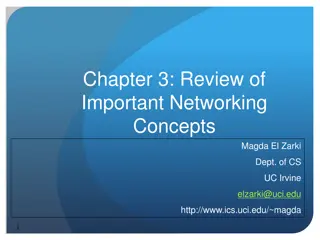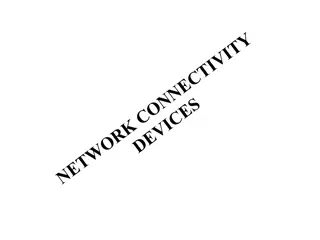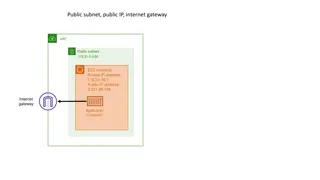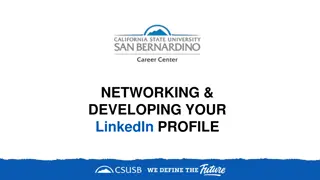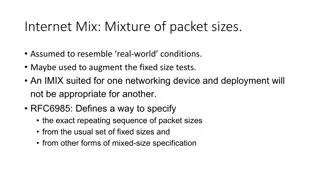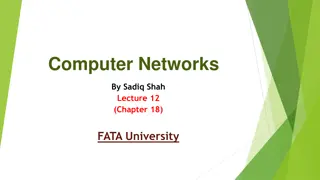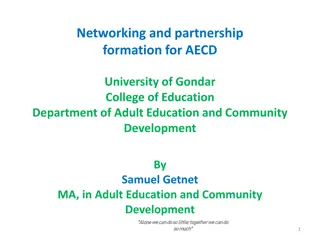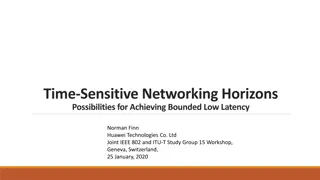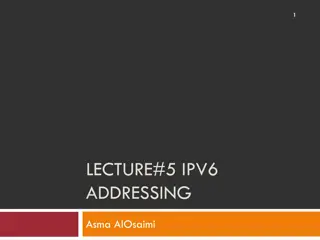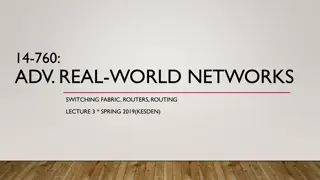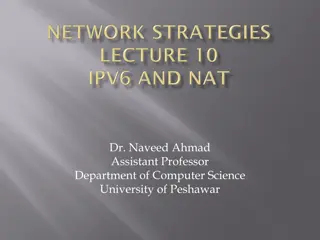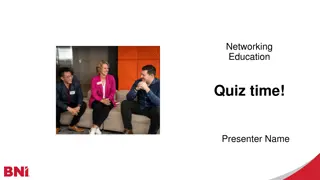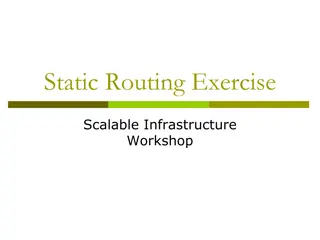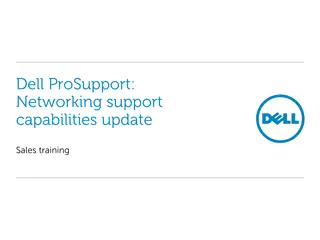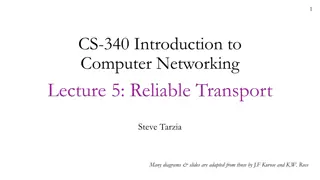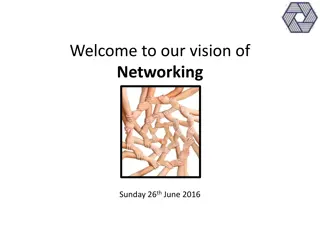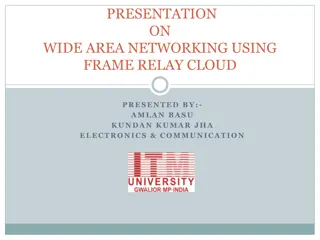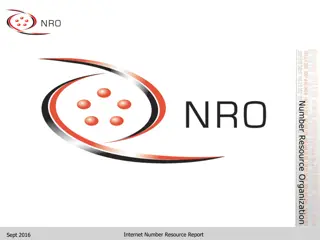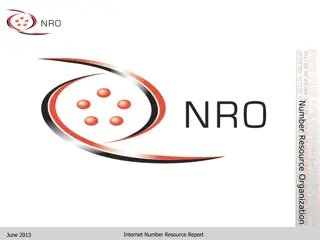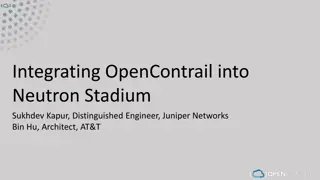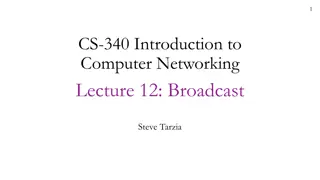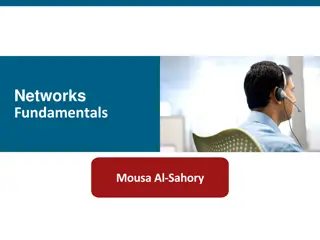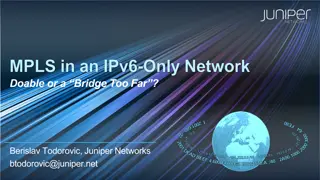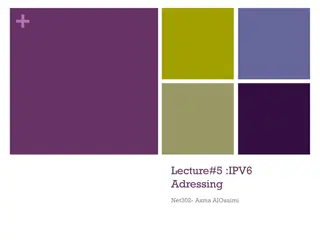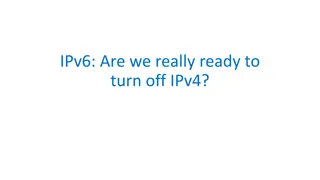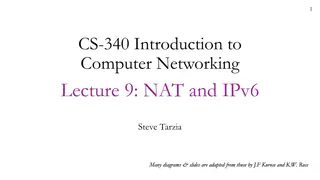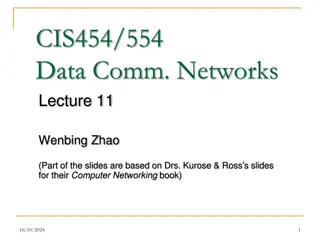Mastering Networking for Career Development
Learn about ethical networking, common myths, building networks, and connecting with others. Discover the art of reciprocal relationships to achieve professional goals. Join the Professional Services Careers Club to enhance your networking skills!
4 views • 31 slides
Important Networking Concepts Overview
Review essential networking concepts including protocol architecture, protocol layers, encapsulation, network abstractions, communication architecture, and TCP/IP protocol suite. Understand the functions of different layers in networking for reliable data transfer and communication efficiency.
3 views • 43 slides
Understanding Networking Bridges and Transceivers
Bridges in networking play a crucial role in dividing logical bus networks into subnets, improving performance by managing traffic flow. Although network switches have largely replaced bridges today, the advantages of bridges in reducing unnecessary traffic and isolating busy networks remain signifi
0 views • 40 slides
Networking Modes in AWS VPC Environments
Explore different networking modes such as Bridge mode with static mapping, Bridge mode with dynamic mapping, and AWS VPC networking mode in an AWS VPC environment with various configurations and scenarios.
0 views • 18 slides
Unlocking the Power of Networking and Developing Your LinkedIn Profile
Networking is a vital aspect of career growth. Learn the art of networking, both in-person and online. Discover the benefits of LinkedIn and how it can enhance your professional connections. Building a strong network opens up opportunities that may lead to career advancement. Utilize these strategie
0 views • 34 slides
Understanding Cabling Types and Specifications in Networking
Exploring various cabling options like Unshielded Twisted Pair, Shielded Twisted Pair, Coaxial Cable, and Fiber Optic Cable used in networking. Learn about different cable specifications, connectivity types, and cabling orders for efficient networking setups.
0 views • 11 slides
Understanding IMIX in Networking and Testing Tools
IMIX, or Internet Mix, refers to a mixture of packet sizes used to simulate real-world network conditions for testing networking devices. Various tools and methods, such as Genome Reporting, Moongen, T-Rex, and Spirent TestCenter, implement IMIX with specific packet size distributions and characteri
1 views • 8 slides
Growth of CA Firms through Networking & Merger
This document discusses the growth and trends of CA firms in India, focusing on networking, merger, and current practices. It highlights the total number of members, types of firm partnerships, guidelines for networking, current trends in practice, barriers to networking/merger, and the 2021 guideli
0 views • 32 slides
Understanding Mobile Computing and TCP/IP Protocol Suite
Mobile computing is crucial for continuous internet connectivity regardless of physical location. The TCP/IP protocol suite, consisting of Transmission Control Protocol (TCP) and Internet Protocol (IP), forms the backbone of internet infrastructure. IP addressing and mobility challenges are addresse
1 views • 51 slides
Diploma in Hardware & Networking: Upgrade Your IT Skills
This course provides comprehensive knowledge and practical experience in computer hardware and networking, essential for managing IT infrastructure. Gain expertise in PC hardware maintenance, customer and networking support, and more to pursue a career as a Hardware and Network Engineer. Learn to as
1 views • 8 slides
Understanding IPv4 Addresses and Classful Addressing in Computer Networks
Explore the basics of IPv4 addresses, address space, hierarchy in addressing, and classful addressing in computer networks. Learn about the unique 32-bit structure of IPv4 addresses, address space calculation, notation methods, and the hierarchical nature of network addressing. Dive into the concept
2 views • 14 slides
Networking and Partnership Formation for AECD at University of Gondar College of Education
Networking and partnership formation are vital for Adult Education and Community Development (AECD) at the University of Gondar, emphasizing the power of collaboration and interdependence. Various concepts such as interdependence, independence, and dependence underscore the importance of working tog
0 views • 120 slides
Networking: Mastering the Basics
Learn the principles and importance of networking, debunking myths and exploring real benefits. Discover networking goals, strategies, and conversation starters for effective networking. Enhance career opportunities, build relationships, and develop valuable connections in various settings.
0 views • 13 slides
Exploring Time-Sensitive Networking Horizons and Possibilities for Low Latency Solutions
Delve into the world of time-sensitive networking (TSN) as it offers bounded low-latency solutions for various applications. Discover TSN components, tools, and protocols such as frame replication, path control, per-stream filtering, time synchronization, and more. Gain insights from Jnos Farkas's p
2 views • 23 slides
Understanding IPv6 Addressing and Migration Techniques
IPv6 is designed as the successor to IPv4 due to the depletion of IPv4 address space. This lecture covers topics such as the need for IPv6, IPv4 and IPv6 coexistence techniques like dual-stack, tunneling, and translation, IPv6 addressing using the hexadecimal number system, and IPv6 address represen
0 views • 30 slides
Networking Fundamentals and Challenges in Data Centers
Today's lecture covers definitions of routing and switching in networking, focusing on data center challenges, traffic patterns, fabric management, and parallelism within networks. The session also explores the role of switches and routers in data center and Internet design, emphasizing the importan
0 views • 38 slides
Evolution of Internet Protocol: From IPv4 to IPv6
The evolution of Internet Protocol (IP) from IPv4 to IPv6 has been crucial for adapting to new technologies and addressing specific networking challenges. IPv6 offers a 128-bit address space, improved header format, extensibility, and support for a wide range of services including video, voice, and
0 views • 23 slides
Understanding the OSI Model and Layered Tasks in Networking
The content highlights the OSI model and layered tasks in networking, explaining the functions of each layer in the OSI model such as Physical Layer, Data Link Layer, Network Layer, Transport Layer, Session Layer, Presentation Layer, and Application Layer. It also discusses the interaction between l
1 views • 41 slides
Networking Education Quiz - Test Your Knowledge!
Test your knowledge on networking education with this quiz featuring questions on SMART goals, INW, BNI basics, leadership team, and more. Challenge yourself to see how much you know about key concepts in the networking field!
0 views • 20 slides
Understanding Static Routing in Network Infrastructure Workshops
Explore the concepts of static routing in networking workshops, covering Unix and Cisco network interface configurations, static routes, default routes, and advantages and disadvantages of static routing. Learn about IP routing configuration, assignment of IPv4 addresses, and FreeBSD network interfa
4 views • 37 slides
Dell ProSupport Networking Support Capabilities Update Sales Training
This training session provides an overview of Dell ProSupport networking support capabilities, focusing on aligning with industry standards. Participants will learn to discuss networking support needs, understand ProSupport differences, and explore Dell's service portfolio. The session covers expert
0 views • 10 slides
Understanding Reliable Transport and User Datagram Protocol in Computer Networking
This content covers the concepts of reliable transport in computer networking, including the reliable transport layer protocols like TCP, UDP, and the basics of Domain Name Service (DNS). It explains the layers of the Internet, the functions of each layer, and the differences between TCP and UDP pro
0 views • 28 slides
Understanding the Importance of Networking for Community Growth
Networking plays a crucial role in fostering supportive relationships within a community, facilitating the exchange of talents, knowledge, and compassion. This article explores the concept of networking, its benefits, disadvantages, and practical steps to establish a structured network within the Os
0 views • 10 slides
Understanding Wide Area Networking Using Frame Relay Cloud
The field of networking is advancing rapidly, with technologies like cloud computing relying on robust wide area networking. This presentation explores the use of Frame Relay Cloud in improving the security and configuration complexities faced in interconnecting wide area networks. It discusses the
0 views • 16 slides
Internet Number Resource Report September 2016
Internet Number Resource Report provides detailed insights into the status of IPv4 and ASN assignments by Regional Internet Registries (RIRs) as of September 2016. The report covers information on IPv4 address space status, available IPv4 /8s in each RIR, IPv4 address space issued by RIRs to custome
0 views • 18 slides
Internet Number Resource Report June 2013
This report provides detailed information on the status of Internet number resources as of June 2013, including IPv4 address space allocations, available IPv4 /8s in each Regional Internet Registry (RIR), IPv4 address space issued by RIRs to customers, ASN assignments, 4-byte ASN assignments, and IP
0 views • 18 slides
Integrating OpenContrail into Neutron Stadium - Networking Advancements
Integrating OpenContrail into Neutron Stadium introduces Networking-OpenContrail, bridging OpenContrail with Neutron to enhance network functionality. The project aims to achieve full parity between the two platforms, with active contributors encouraged to join the development efforts. Deployment op
0 views • 7 slides
Understanding Computer Networking: Broadcast and Multicast Protocols
In this lecture on computer networking, we explore the concepts of broadcast and multicast protocols. The discussion covers topics such as BGP routing, IPv4 anycast hack, IP multicast, and the role of broadcast in small-to-moderate sized ad hoc networks. Learn about the differences between unicast,
0 views • 20 slides
Understanding IPv4 Addressing and Classes
Explore the fundamentals of IPv4 addressing including subnetting, VLSM, summarization, subnet masks, CIDR values, available host addresses, and broadcast addresses. Learn about IPv4 classes A, B, C, and D, their formats, usage for different network sizes, netmask details, IP address ranges, and more
0 views • 38 slides
Maximizing Networking Opportunities at Career Fairs and Conferences
Enhance your networking skills with practical tips on approaching strangers, asking insightful questions, and making lasting connections at career fairs and conferences. Understand the importance of networking for knowledge sharing, collaboration, and discovering hidden job opportunities. Learn the
0 views • 21 slides
Navigating IPv6 and MPLS Challenges for IPv4 Core Edge Transition
Explore the transition solutions and challenges for integrating IPv6 at the edge of an IPv4 core network, including 6PE, 6VPE, MPLS transport options, and the potential for IPv4 elimination. Discover the evolution toward IPv6 adoption in networking standards and the persistent role of MPLS in modern
0 views • 25 slides
Internet Resource Status Report as of 31 March 2018
This report provides detailed information on the status of Internet number resources as of March 2018, including IPv4 address space allocation, available IPv4 /8s in each Regional Internet Registry (RIR), IPv4 address space issued by RIRs to customers, ASN assignments by year and total ASN assignmen
0 views • 18 slides
IPv6 Addressing and Coexistence: Overview and Challenges
This lecture covers essential topics on IPv6 addressing, including IPv4 issues, the need for IPv6, address representation, types, testing, and verification. It explains how IPv6 is designed to overcome the limitations of IPv4, particularly the depletion of the IPv4 address space. The discussion also
0 views • 44 slides
Evolution of IPv6 Adoption in the Networking Industry
IPv6 adoption has reached 30% globally by the start of 2022. However, progress varies among different sectors, with enterprises lagging behind consumer markets. The slow transition is attributed to market saturation, legacy network issues, and cost considerations. Despite the benefits of IPv6 deploy
0 views • 6 slides
The State of IPv6 Transition: Are We Ready to Turn Off IPv4?
Despite decades of effort, the transition from IPv4 to IPv6 has been slow. Currently stuck in Phase 2, with only a small percentage of Internet users having IPv6 capabilities. New deployments lean towards IPv6 but the majority still rely on IPv4, with gradual migrations to dual-stack for legacy netw
1 views • 49 slides
Understanding IP Addresses and Their Classification
IP Addresses, short for Internet Protocol addresses, are unique identifiers assigned to devices on a network. They can be IPv4 or IPv6, with IPv4 having 32 bits and IPv6 being 128 bits. IP addresses are classified into classes A, B, and C, each with specific range and usage. Understanding IP address
0 views • 14 slides
IPv6 Public Policy Considerations - Addressing the Global IP Address Shortage
In light of the global shortage of IPv4 addresses, there is a pressing need for a fair policy for the allocation of remaining addresses. The rapid growth of the Internet has further increased demand for IP addresses, with IPv4 expected to run out soon. The deployment of IPv6 has become a critical is
0 views • 23 slides
Understanding NAT and IPv6 in Computer Networking
This lecture covers Network Address Translation (NAT) and IPv6 basics in computer networking. It explains how NAT helps in connecting multiple devices to the internet with limited IPv4 addresses, the concept of public and private IP addresses, and the transition to IPv6 for addressing constraints. V
1 views • 31 slides
Understanding IPv4 Networking Fundamentals
Explore crucial concepts in IPv4 networking, including addressing, protocol formats, network layer functions, datagram structure, header details, time-to-live considerations, and checksum verification. Delve into the intricacies of Internet Protocol version 4 to grasp the foundations of data communi
0 views • 31 slides
The Future of Fast Data Processing with fd.io VPP
Explore the future of fast data processing through the innovative fd.io VPP technology. VPP stands as a high-performance packet processing platform running on commodity CPUs. It leverages DPDK for optimal data plane management and boasts fully programmable features like IPv4/IPv6 support, MPLS-GRE,
0 views • 15 slides

